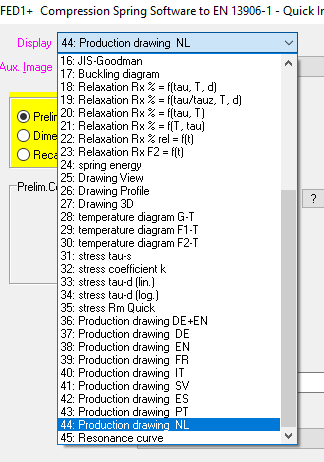
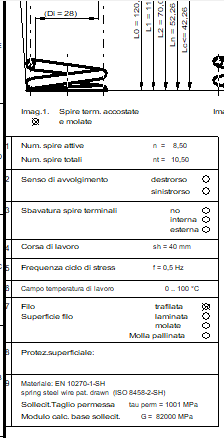
 | English
| Deutsch
| English
| Deutsch
FED1+, FED2+: Quick Input including international production drawing
The production drawing in English, German, French, Italian, Spanish, Portuguese, Swedish, Dutch can now also be displayed in the background window of the Quick Input with "Display".


Material database fedwst.dbf French
For hot-rolled spring steel, the term "chaux" has been corrected to "chaud".

FED6: Quick Input
In the new quick input, all input windows for the recalculation of a non-linear cylindrical compression spring have been combined in one large input window.

Dimensioning of a spring by definition of the progressive spring characteristic curve is not covered by the Quick Input. For this case, use the menu items "Spring characteristic F-s", "Spring characteristic F-L" or "Spring characteristic F-R, L" in the Edit menu. Under "Help \ Expert Mode" you can switch off the expert mode, then only the absolutely necessary menu items are displayed.
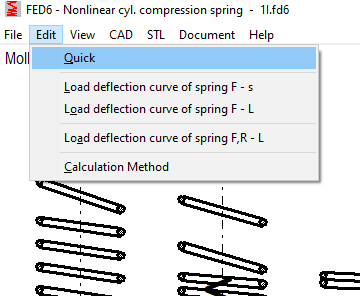
SR1: Load extension diagrams

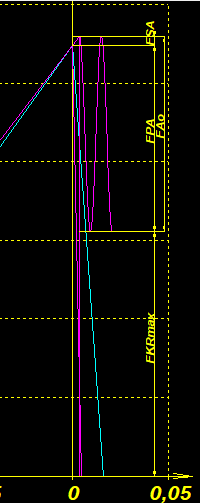
FSA and FPA are now drawn in the load-extension diagram in operating state (min / max / req). This is the distribution of the external force FA (FAo) on the bolt (S) and the plates (P).
This also results in the residual clamping force FKR. This is now no longer drawn as a point, but like a dimension.
Incidentally, a symbolic representation of a sine curve is only drawn in when FAu = 0. Because FAu is not taken into account in the stress diagrams. Exception: FAo and FAu are both less than 0 (pressure load), then FSA and FPA become negative. Otherwise, FAu is only used to calculate the stress amplitude sigmaA. In the assembled state, FAu = 0 and FAo = 0.
Load-extension diagram "Operating condition min" is the representation with the smallest assembly load, but with the largest axial load FA (FAo). This gives the (smallest) residual clamping force FKR.
Under "View \ Diagrams" all load-extension diagrams except for "Operating condition min." were shown. That has now been added. The "MA-FM diagram" is omitted instead.
WN2, WN2+: Quick Input
In the quick input, all previous input windows are combined into one large input window. The previous single entry windows are still available. If that is too confusing for you, you can switch off the "Expert Mode", then the menu is reduced to the most important items. Under "Edit" there is then only "Quick Input".
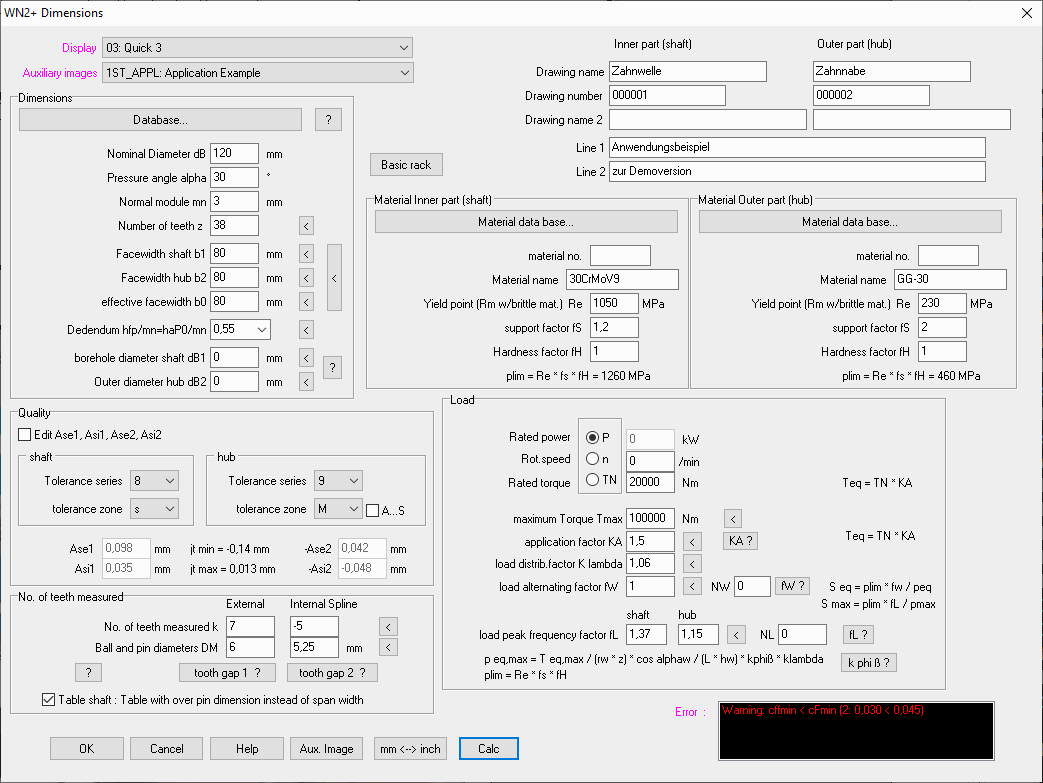
WN2: New error message (if large backlash)
------------------------------------------------- ---------------------
Warning: da1 min h11> da1 (xemax)
Cause: The minimum tip diameter according to DIN 5480 is intersected by the gear cutting tool.
Remedy: Edit \ Quality: Reduce dimensions.
-------------------------------------------------- --------------------
Warning: da2 max H11 <da2 (xemax)
Cause: Maximum tip diameter of the internal toothing according to DIN 5480 is cut by the gear cutting tool.
Remedy: Edit \ Quality: Reduce dimensions.
-------------------------------------------------- --------------------
If a large backlash is selected, then not only the tooth thickness but also the tip and root diameter are smaller when manufacturing using the hobbing process. If the tip diameter becomes smaller than the lower limit of the ISO tolerance h11 (H11 for internal gearing), there is now a new error message. To avoid the warning, the backlash can be distributed over the shaft and hub. Example: Tolerance pairing D7 / c7 instead of H7 / a7.
WN2: Press fit and generated tip diameter
With tolerance field "j .. v" or "J .. M" the tip circle generated by the tool is larger than the nominal value "da nom". Therefore the tip circle is now reduced by changing the tip height to the tolerance center of "da nom h11 / H11". This increases the head clearance and form oversize cF.
WN2: Toothing table with tip diameter w/o tip reduction
With tolerance field "j .. v" or "J .. M" the tip diameter calculated from xemin and xemax is larger than the nominal diameter "da nom". Therefore, "da" is cut to the tolerance center "da nom h11 / H11" by means of a tip reduction. In this case, "da" and "k * m" are displayed in the toothing table instead of "da (xemin)" and "da (xemax)".
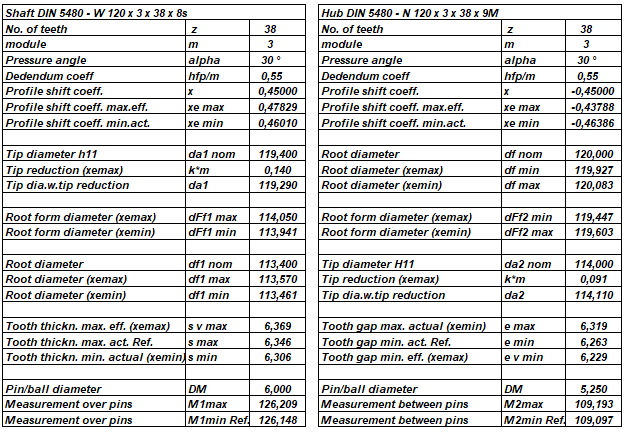
The limit value of the form circle diameter "dff lim" is no longer displayed in the gear table, as it is dependent on the counterpart and therefore only applies to the selected shaft / hub joint.
WN2: DIN 5480
In the last info letter it was stated that DIN 5480 does not specify how form diameters are calculated. That was poorly researched, because it is actually described very precisely in DIN 5480 Part 16. Of DIN 5480 there is Part 1, Part 2, Part 15 and Part 16. Part 1 is the most important. Part 2 is not needed, the table values can be calculated in WN2. Part 15 concerns plug gauges and ring gauges. Part 16 concerns the production of the toothing with hob and broaching tool. Parts 3 to 14 no longer exist. In the past, these were different measurement tables that were recombined in Part 2.
In your DIN 5480-1: 2006 you can change the formula for df1 in table 5 from
Adf1 = - (0.2m + 1.73 * (- As + TG))
in
Adf1 = - ((1.3-2 * hfp) * m + 1.73 * (- As + TG))
Then the formula no longer only applies for hfP = 0.55 * m, but also for 0.6 * m and 0.65 * m
This means that the specifications from DIN 5480-1 Chapter 7 are implemented.
WN4: Quick Input

The individual input windows were integrated in the new Quick Input.
WN5: Quick Input

The individual input windows were integrated in the new Quick Input.
WN4,WN5: Production Drawing: Bore, outside diameter and length dimensioned.


WN8: Root fillet for non-standard sizes added in the database

DIN 5481 for serrations covers the sizes 7x8 to 55x60. There are also 60x65 to 120x125 in the WN8 database. For these non-standardized sizes, fillet radii have been added in the database (RI_MAX and RE_MAX).
WN8: Input tolerance tooth thickness and tooth gap for tooth profile drawing
Similar to involute splined shaft-hub joints, you can now also enter a value in WN8 in the CAD and STL menu, which determines the flank clearance and backlash. With WN8 this is the tooth thickness on the splined shaft and the gap width on the toothed hub. Min / Max is the upper and lower dimension, which is calculated from the ISO tolerances A11 / a11 from Dii and Dee. For the production by eroding or 3D printing, the flank clearance can be changed within the tolerance limits. The default value is the tolerance center.
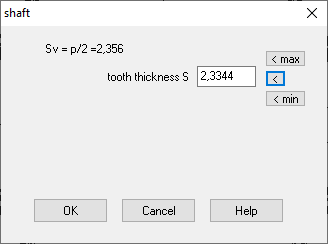
SR1 Tip: How to consider a chamfer

If a high surface pressure is to be expected due to a small overlap, the additional reduction of the clamping surface due to a chamfer should also be taken into account. To do this, a clamping plate is divided into two clamping plates. The chamfer is considered to be a cylindrical countersink. The inner diameter of the additional clamping plate is the chamfer diameter, the height of the clamping plate is the height of the chamfer.
Applied to example 1 from VDI 2230, a chamfer of 1x45 ° would be clearly too big, an error message "p perm clamping plate 1! (S = 0.87) "is the consequence.
SR1 Tip: Countersink due to thread run-out


The thread length is always smaller than the shaft length. There is no "thread to head" with short screws, with rolled and cut threads you need between 2 and 5 thread turns. If you screw thin sheet metal directly, the screw run-out runs onto the thread (error message "lG3 Bolt <0!"). Then you either need a washer, or the nut thread has a cylindrical or conical countersink (or the screw has an undercut, but this is not recommended for reasons of strength). This countersink is modeled in SR1 by defining an additional clamping plate with the height of the countersink and shortening the nut by the same height (see above).
Tip: Settings when changing the font size in Windows 10

In Windows 10 you can change the display under "Settings \ System \ Display \ Scaling" in steps of 100%, 125%, 150%, 200%. However, this also reduces the graphics resolution. Alternatively, you can change the size in HEXAGON software without changing the Windows system settings. To do this, increase the size of the dialog window and dialog element size under "File\Settings\Graphics". Also check whether the large Quick Input window still fits into your screen when the window size is changed. Otherwise "sizeable?" tick for scroll bar in all input windows.
Corona, the fourth
As expected, those returning from vacation bring the fourth corona wave with them. Most of the Balkan countries, just like in 2020. At the top Kosovo, Turkey, Croatia according to RKI from 12.8.2021. In Germany, people who have not been vaccinated are being pressured to finally get vaccinated. Perhaps a little hasty: the vaccine will soon run out again because the vaccinated will come back and ask for their third vaccination. Because the syringe from Biontech and Co. no longer provides protection after 6 months.
Corona: Superspreader with vaccination certificate
SWR report: A total of 34 infections are currently reported around the party night in the "Topsy Turvy" on 2.7.21, according to the Karlsruhe health department. Six people are said to have tested positive, despite full vaccination protection. The virus was alleged to have been spread by an infected woman returning home from Mallorca. She was not tested because she was vaccinated.
Zdf.de from August 11, 2021: Israel is still a long way from herd immunity. At first glance, the vaccination status of the 400 people who are in hospital with severe courses is particularly surprising and frightening (as of August 11, 1 p.m.): 140 are not vaccinated at all, 10 are single and 240 are even double vaccinated.
RKI weekly report of August 12th, 2021: 13.5% of the new corona infected people with severe disease were fully vaccinated (technical jargon: hospitalized symptomatic breakthroughs in vaccination).
Conclusion: vaccination does not protect against infection. Since the vaccination is supposed to protect against severe disease and the proportion of those who are vaccinated is still 13.5%, the proportion of those who are vaccinated in all new corona infections may be estimated to be 50%. There are no figures on this because vaccinated people are not tested.
Travel tip: Stasi headquarters and BND headquarters in Berlin
If you visit the former Stasi headquarters in Hohenschönhausen in Berlin, you should also visit the new BND headquarters in Berlin-Mitte, on the ground where the GDR's Olympic Stadium and Olympic Village should originally have been built. It is now overbuilt with modern office wings. At the edge is a park with a renatured stream, the Panke. Adorned with an artificial giant palm made of sheet metal and concrete. A new street was built especially for the BND parking garage, Idi-Amin-Street (or similar).